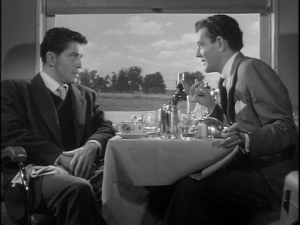
 Over the next two months, Film Forum is showing the complete films of both Alfred Hitchcock and Francois Truffaut. In honor of this pairing, we will preview the Hitchcock films using insights from the directors’ own conversations in Hitchcock/Truffaut, Truffaut’s landmark book of interviews.
Over the next two months, Film Forum is showing the complete films of both Alfred Hitchcock and Francois Truffaut. In honor of this pairing, we will preview the Hitchcock films using insights from the directors’ own conversations in Hitchcock/Truffaut, Truffaut’s landmark book of interviews.
On Friday, the Complete Hitchcock series continues with “Strangers on a Train,” a 1951 effort that began the master’s most brilliant decade of work. The film’s first three minutes show a train station, but the camera never rises above waist level. Hitchcock shows us the myriad switches and crossings of the train tracks, along with anonymous pairs of legs walking through the station, crossing paths, making and missing connections; a world of infinite possibilities, where one chance encounter can change a life, or end another.
Two such pairs of legs do meet and Hitchcock tilts up to show us the faces of Guy and Bruno. Guy is a handsome tennis player who simply wants to read, but Bruno, a slippery character who seems to know everything about Guy, keeps drawing him into conversation. Bruno flatters Guy through his knowledge of Guy’s tennis career, but Bruno, who “sometimes turns the sports page to the society pages,” also knows that Guy’s wife is cheating on him and that Guy has been seen around town with a senator’s daughter. Guy is unsettled by these personal revelations, but seems too weak to definitively turn away Bruno, whose ingratiating manner disguises a sociopathic interior. The conversation is essentially a seduction and takes on homoerotic undertones as Bruno brings up an idea, first hypothetically, but then with greater and greater conviction.
Bruno’s idea is a murder swap – for two people to enter an agreement and kill the other’s desired target, so each man is killing a perfect stranger with no motive while the other has a perfect alibi for the killing. Bruno wants his overbearing father dead and surmises that Guy, who has political aspirations beyond tennis, would benefit greatly from his wife’s death. Guy rebuffs Bruno’s plot, but Bruno kills Guy’s wife anyway, and begins pressuring Guy to fulfill his end of the bargain he never agreed to. Meanwhile, Guy becomes the prime suspect in his wife’s murder; he had a strong motive, was seen fighting with her that day, and he can’t prove an alibi. Bruno tries to coerce Guy to kill as Guy tries to clear his name from suspicion, without being able to go to the police.
The film’s creation was a remarkable meeting of mystery writers – Raymond Chandler helped adapt Patricia Highsmith’s novel, though Hitchcock describes Chandler’s work on the script as “no good.” This is perhaps unsurprising, since Chandler’s mysteries focus more on character and atmosphere, often with little real resolution, and Hitchcock preferred plots with an almost mathematical precision. Hitchcock tells Truffaut, “the great problem with this type of picture, you see, is that your main characters sometimes tend to become mere figures.” But this interchangeability can often be a virtue in Hitchcock films. The characters might not be fully fleshed individuals, but instead serve as embodiments of traits and tendencies. Truffaut points out that “both characters might very well have had the same name. Whether it’s Guy or Bruno, it’s obviously a single personality split in two.” While Bruno committed the actual murder, he was encouraged by Guy’s weakness and inability to reject his plot out of hand. Guy realizes this, feeling, as Hitchcock says, that “it’s just as if he had committed the murder himself.”
The chance meeting of these two characters leads to murder and one of Hitchcock’s most riveting thrillers. “Strangers on a Train” plays Friday at Film Forum.